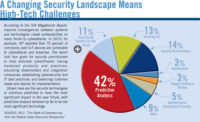With new technologies making security cameras more affordable and flexible, home surveillance systems are changing. Installations and placement don’t look the same as they did years ago, though some of the dealer concerns such as privacy, wiring and lighting optimization remain. Security dealers talked to SDM eNews about how an evolving technology landscape is changing the way cameras are installed in a home and opening up new markets.
Jack Rosenbrough, corporate security manager at Koorsen Fire & Security, a company specializing in residential and small commercial clients, pointed out that, “The biggest thing with location in residential applications is that we have to be aware of privacy issues. In the home, people have a right to privacy. When it’s a fixed camera outdoors, we do have to be careful not to be looking into a neighbor’s house or window. Just like in a business where we’re not going to aim a camera at an exam room or a restroom, we’re going to block that area out of the camera. We are a little more sensitive to that residentially.”
Secondary to privacy, according to Rosenbrough, the biggest challenges when it comes to placing cameras in a home boil down to installation, appearance and lighting. He comments that when using “wired, more traditional cameras, a home is certainly more challenging than a warehouse when it comes to pulling wire and/or getting to the internet gateway in the house. So we definitely have more issues, such as trying to get coax cable or cat5 cable routed to an upstairs office where a router is.”
The aesthetics of the cameras itself is also a concern for many homeowners, both inside and outside the home. Sometimes what an installer deems the best logistical solution can seem intrusive to a homeowner. “The appearance of the cameras and the location of the cameras sometimes takes a precedent over the actual view. You don’t want a big camera hanging over the mantle in your fireplace. But one of the advantages is that they have gotten smaller and more attractive as time has gone on. We use a lot more domes than we do full body cameras. We do get more requests for covert cameras residentially. Especially if it’s a nanny cam situation.”
Finally, lighting is a consideration Koorsen spends a lot of time on in the surveying stages of the design process. “Lighting is probably the number one concern with a CCTV system. That’s certainly one of our survey questions to find out about, and preferably even go see, what the lighting condition is in this area. We may need to go to day/night or low-light cameras or we can go to infrared illuminated cameras and we’ll see in complete darkness. More often, rather than putting in a more expensive IR camera, the customer will prefer to address the lighting issue by adding lights themselves.”
Wireless cameras have “dramatically” increased possibilities for where cameras can be installed in a home, Ronsebrough stressed. “We have the flexibility to mount cameras or leave them portable — even with the wireless ones — which is what has really opened up the door to the customer, being able to move that camera for different purposes and different uses at different times, whether it be keeping an eye on things while on vacation or watching a babysitter.”
Rosenbrough shared that issues with placement of cameras more often stems from not capturing enough of what the customer wanted to see, rather than too much. “If we ever have a problem with a camera system and a customer, it’s probably because we designed the wrong solution for what they wanted or we didn’t truly understand what their needs were.”
This is an area where Rosenbrough feels wireless cameras can help achieve what the customer wants at different times. “The wireless IP cameras can be plugged into an RJ45 internet connection or wireless, but they do have to have power. As long as there’s an outlet, they can actually move that camera. So it has opened up a little more flexibility in offering that solution to the customer and saying, ‘I know your main concern is seeing your driveway, we’ll mount an outdoor camera out there so you can see deliveries or the school bus, or whatever it is you’re concerned about. Let’s put another one in your living room and you can move these. So if for any reason there should be another sensitive area or something else they want to see, they have that ability.
“We haven’t run into any issues of privacy where the customer puts the camera somewhere they possibly shouldn’t. Sometimes the spouse isn’t always thrilled with the fact that they can always be viewed inside the house. But the customer can really choose where the location of the camera is. And that really brings some value to it,” Rosenbrough added.
Though camera placement is very much up to the customer, not every job needs to be a custom job. “We have bundles and split that with traditional camera systems, which is going to be a DVR and x number of cameras,” Rosenbrough explained. “So we have three different residential packages — one for indoor, one for outdoor, one for a combination of the two — for a fixed price and we can modify from there. We’ve done the same thing with the wireless IP video Total Connect cameras.
“Residential security reps traditionally have not sold a lot of CCTV because of the price and the possible complexity of the design. But now we can say we’ll sell you one outdoor camera and a wireless access point or one indoor, or one pan-tilt. So we created some packages with those and then it’s a la carte. The biggest thing is determining whether we’re going a traditional CCTV route or whether the wireless IP solution will work. Because there are limitations with cloud storage and wireless IP. It’s not true 24-hour recording like a DVR is, and that’s also the cost savings. The hard part is doing enough needs analysis to figure out what it is you’re trying to accomplish with the solution.”
When it comes to video, affordability has historically been a deterrent for a large portion of the residential market. New technologies are changing that trend. “Removing the DVR was the big price saving for the customer and storing the video clips via the cloud via Total Connect is how we were able to do that,” Rosenbrough commented. “All we have to do is put in a camera and possibly a wireless access point on their router and it’s very little cost to them.”
“The whole trick to selling video is, obviously what you want is your customer’s expectations to be met. So when the product is installed and they’re actually looking at the video, they say, ‘Oh yeah, this is what I wanted to see.’ We need to understand how close they want it to be. The way we’ve done that successfully is twofold. First, we continue to do a very good needs analysis. We have a form and we ask all of our questions and really probe and have the customer tell us what they’re looking for with a lot of pointed questions: lighting conditions, detail, size, do we need to see faces? what is it we’re trying to see? And second, we’ve equipped all of our reps with iPads so they can demonstrate the cameras and show the customer actual views of actual models and actual installations. We’ve installed demo systems and we can show them how the interface looks, how it’s going to look in their computer or their iPad, how to playback video, how to see a video clip of their daughter coming home, or whatever it may be.”
A home surveillance system can take many forms. And the center of that is customer need. A customer may be highly concerned with keeping a close watch on valuable items, or covering entrances and windows to provide a forensic record of any break-ins. At the same time, another customer may want to focus on the activities of the people who are supposed to be in the house, such as children and teenagers coming and going from school, an elderly family member on their own, or as a supervision tool for a nanny or other employee.
Self-monitoring is currently a big growth sector for residential video. Gary Franklyn, vice president, business development, Security Networks, noted an increase in residential video applications that allow customers to check in on their home remotely. “With the advent of interactive services from both Honeywell and Alarm.com, more homeowners are talking advantage of video interactive services to use cameras as a nanny cam and view outdoor cameras [for deliveries, arrivals, etc.].”
An obvious advantage of self-monitored video is the absence of a third-party or dealer-owned monitoring station having access to events happening inside a home. And some believe that can be an incentive for homeowners who are on the fence about security, but find value in video. The opportunity for RMR still exists as companies such as Security Networks’ affiliates and Koorsen Fire & Security can charge a monthly hosting fee that allows customers to stream live video and store video clips in the cloud.








